BISY2005: Enterprise Systems Advantages and Integration
VerifiedAdded on 2022/08/31
|14
|3814
|18
Essay
AI Summary
This essay delves into the realm of enterprise systems, emphasizing their crucial role in modern business operations. It begins by highlighting the key advantages of implementing such systems, including data storage in a usable format, automation of customer service processes, scalability of IT capabilities, and enhanced IT infrastructure reliability. The essay then explores the critical role of Enterprise Resource Planning (ERP) systems in system integration, particularly in connecting with Enterprise Performance Management (EPM) software to streamline planning, reporting, and decision-making. Furthermore, the essay provides an in-depth analysis of three different types of ERP architectures: web service architecture, layered architecture, and service-oriented architecture, comparing and contrasting their strengths and weaknesses. The discussion also examines the challenges associated with web service architecture, particularly in development and implementation, while underscoring the importance of ERP architecture in ensuring usability, flexibility, and scalability within a business context.

Running head: MARKETING
Enterprise System
Name of the Student:
Name of the University:
Author Note:
Enterprise System
Name of the Student:
Name of the University:
Author Note:
Paraphrase This Document
Need a fresh take? Get an instant paraphrase of this document with our AI Paraphraser
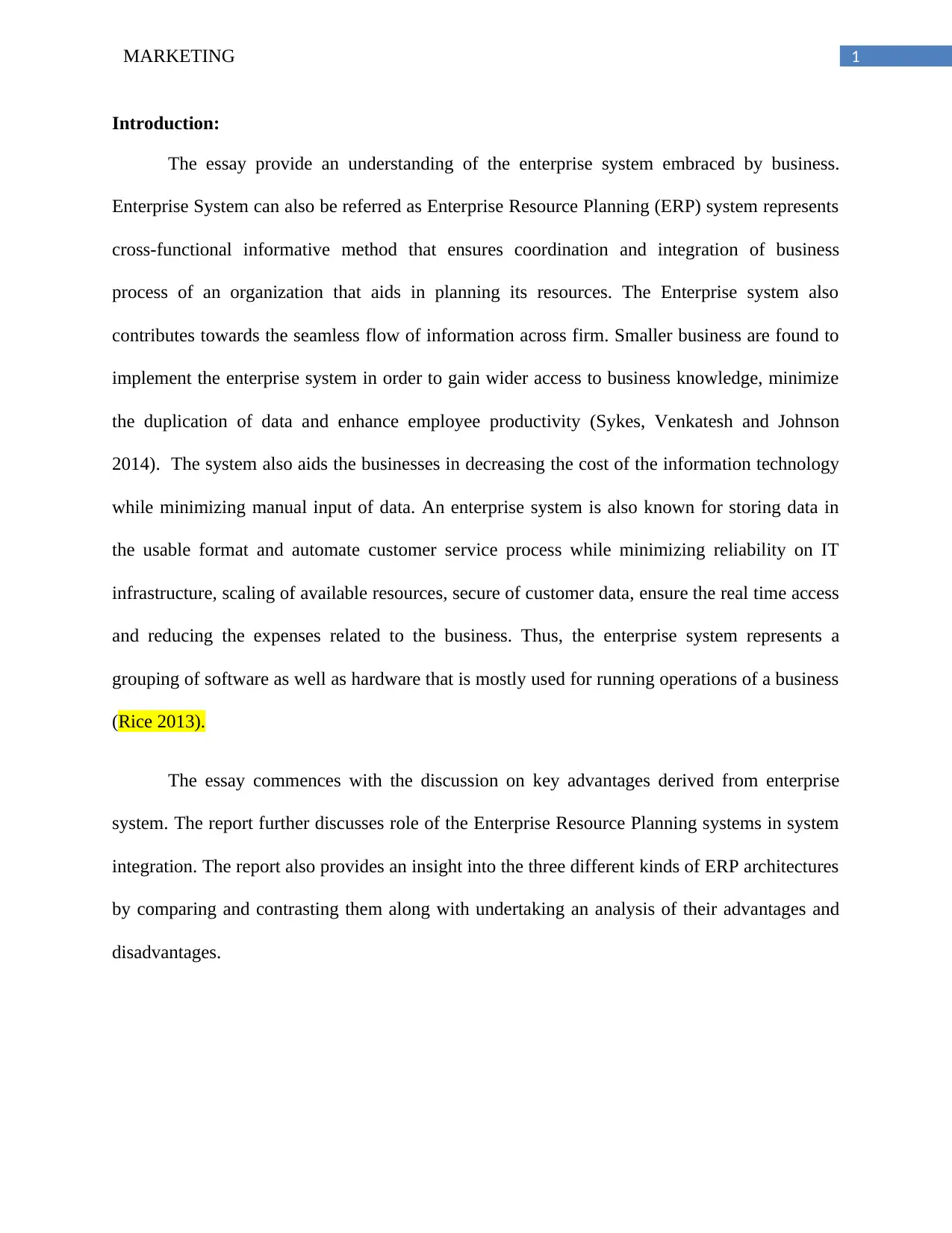
MARKETING 1
Introduction:
The essay provide an understanding of the enterprise system embraced by business.
Enterprise System can also be referred as Enterprise Resource Planning (ERP) system represents
cross-functional informative method that ensures coordination and integration of business
process of an organization that aids in planning its resources. The Enterprise system also
contributes towards the seamless flow of information across firm. Smaller business are found to
implement the enterprise system in order to gain wider access to business knowledge, minimize
the duplication of data and enhance employee productivity (Sykes, Venkatesh and Johnson
2014). The system also aids the businesses in decreasing the cost of the information technology
while minimizing manual input of data. An enterprise system is also known for storing data in
the usable format and automate customer service process while minimizing reliability on IT
infrastructure, scaling of available resources, secure of customer data, ensure the real time access
and reducing the expenses related to the business. Thus, the enterprise system represents a
grouping of software as well as hardware that is mostly used for running operations of a business
(Rice 2013).
The essay commences with the discussion on key advantages derived from enterprise
system. The report further discusses role of the Enterprise Resource Planning systems in system
integration. The report also provides an insight into the three different kinds of ERP architectures
by comparing and contrasting them along with undertaking an analysis of their advantages and
disadvantages.
Introduction:
The essay provide an understanding of the enterprise system embraced by business.
Enterprise System can also be referred as Enterprise Resource Planning (ERP) system represents
cross-functional informative method that ensures coordination and integration of business
process of an organization that aids in planning its resources. The Enterprise system also
contributes towards the seamless flow of information across firm. Smaller business are found to
implement the enterprise system in order to gain wider access to business knowledge, minimize
the duplication of data and enhance employee productivity (Sykes, Venkatesh and Johnson
2014). The system also aids the businesses in decreasing the cost of the information technology
while minimizing manual input of data. An enterprise system is also known for storing data in
the usable format and automate customer service process while minimizing reliability on IT
infrastructure, scaling of available resources, secure of customer data, ensure the real time access
and reducing the expenses related to the business. Thus, the enterprise system represents a
grouping of software as well as hardware that is mostly used for running operations of a business
(Rice 2013).
The essay commences with the discussion on key advantages derived from enterprise
system. The report further discusses role of the Enterprise Resource Planning systems in system
integration. The report also provides an insight into the three different kinds of ERP architectures
by comparing and contrasting them along with undertaking an analysis of their advantages and
disadvantages.
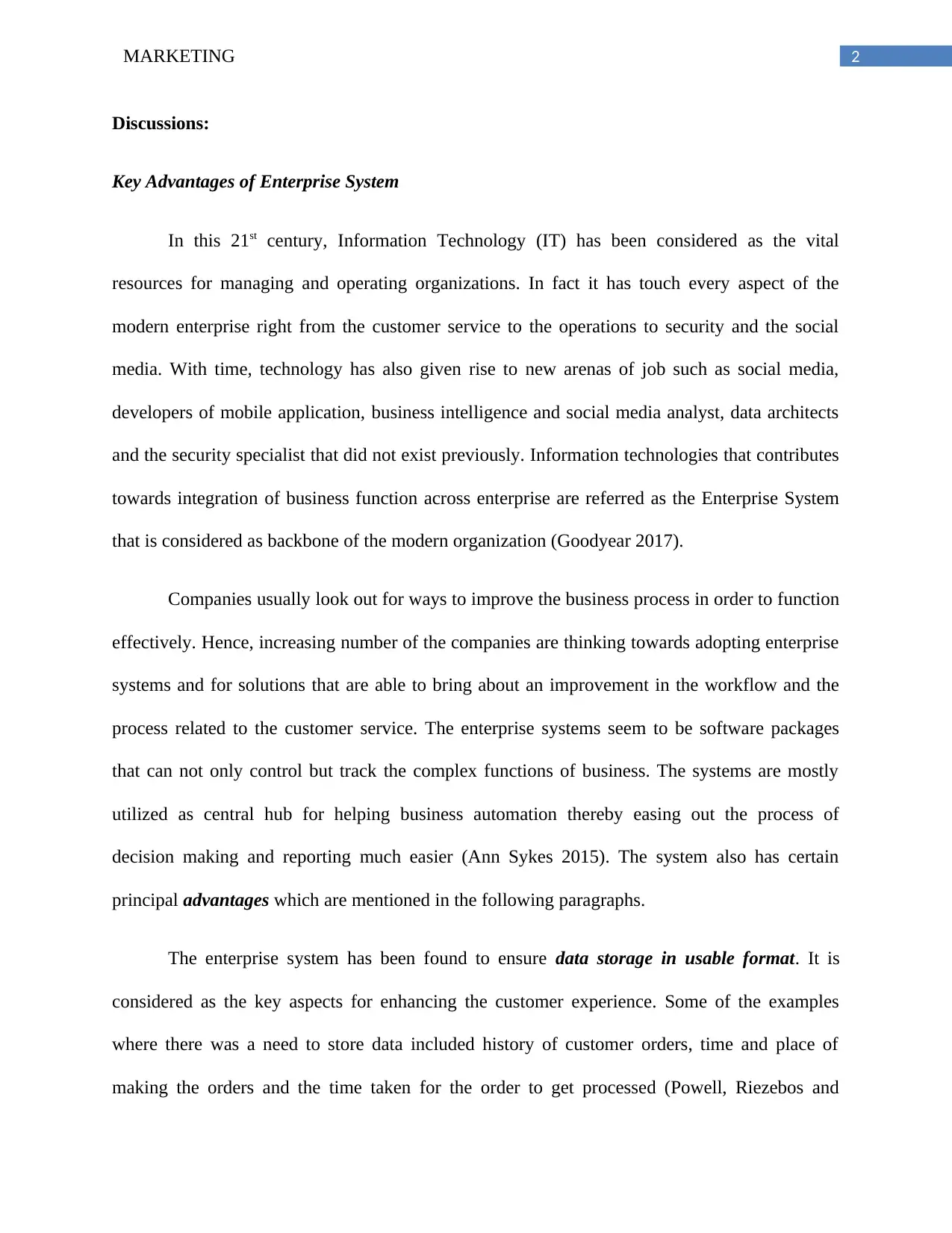
2MARKETING
Discussions:
Key Advantages of Enterprise System
In this 21st century, Information Technology (IT) has been considered as the vital
resources for managing and operating organizations. In fact it has touch every aspect of the
modern enterprise right from the customer service to the operations to security and the social
media. With time, technology has also given rise to new arenas of job such as social media,
developers of mobile application, business intelligence and social media analyst, data architects
and the security specialist that did not exist previously. Information technologies that contributes
towards integration of business function across enterprise are referred as the Enterprise System
that is considered as backbone of the modern organization (Goodyear 2017).
Companies usually look out for ways to improve the business process in order to function
effectively. Hence, increasing number of the companies are thinking towards adopting enterprise
systems and for solutions that are able to bring about an improvement in the workflow and the
process related to the customer service. The enterprise systems seem to be software packages
that can not only control but track the complex functions of business. The systems are mostly
utilized as central hub for helping business automation thereby easing out the process of
decision making and reporting much easier (Ann Sykes 2015). The system also has certain
principal advantages which are mentioned in the following paragraphs.
The enterprise system has been found to ensure data storage in usable format. It is
considered as the key aspects for enhancing the customer experience. Some of the examples
where there was a need to store data included history of customer orders, time and place of
making the orders and the time taken for the order to get processed (Powell, Riezebos and
Discussions:
Key Advantages of Enterprise System
In this 21st century, Information Technology (IT) has been considered as the vital
resources for managing and operating organizations. In fact it has touch every aspect of the
modern enterprise right from the customer service to the operations to security and the social
media. With time, technology has also given rise to new arenas of job such as social media,
developers of mobile application, business intelligence and social media analyst, data architects
and the security specialist that did not exist previously. Information technologies that contributes
towards integration of business function across enterprise are referred as the Enterprise System
that is considered as backbone of the modern organization (Goodyear 2017).
Companies usually look out for ways to improve the business process in order to function
effectively. Hence, increasing number of the companies are thinking towards adopting enterprise
systems and for solutions that are able to bring about an improvement in the workflow and the
process related to the customer service. The enterprise systems seem to be software packages
that can not only control but track the complex functions of business. The systems are mostly
utilized as central hub for helping business automation thereby easing out the process of
decision making and reporting much easier (Ann Sykes 2015). The system also has certain
principal advantages which are mentioned in the following paragraphs.
The enterprise system has been found to ensure data storage in usable format. It is
considered as the key aspects for enhancing the customer experience. Some of the examples
where there was a need to store data included history of customer orders, time and place of
making the orders and the time taken for the order to get processed (Powell, Riezebos and
⊘ This is a preview!⊘
Do you want full access?
Subscribe today to unlock all pages.

Trusted by 1+ million students worldwide
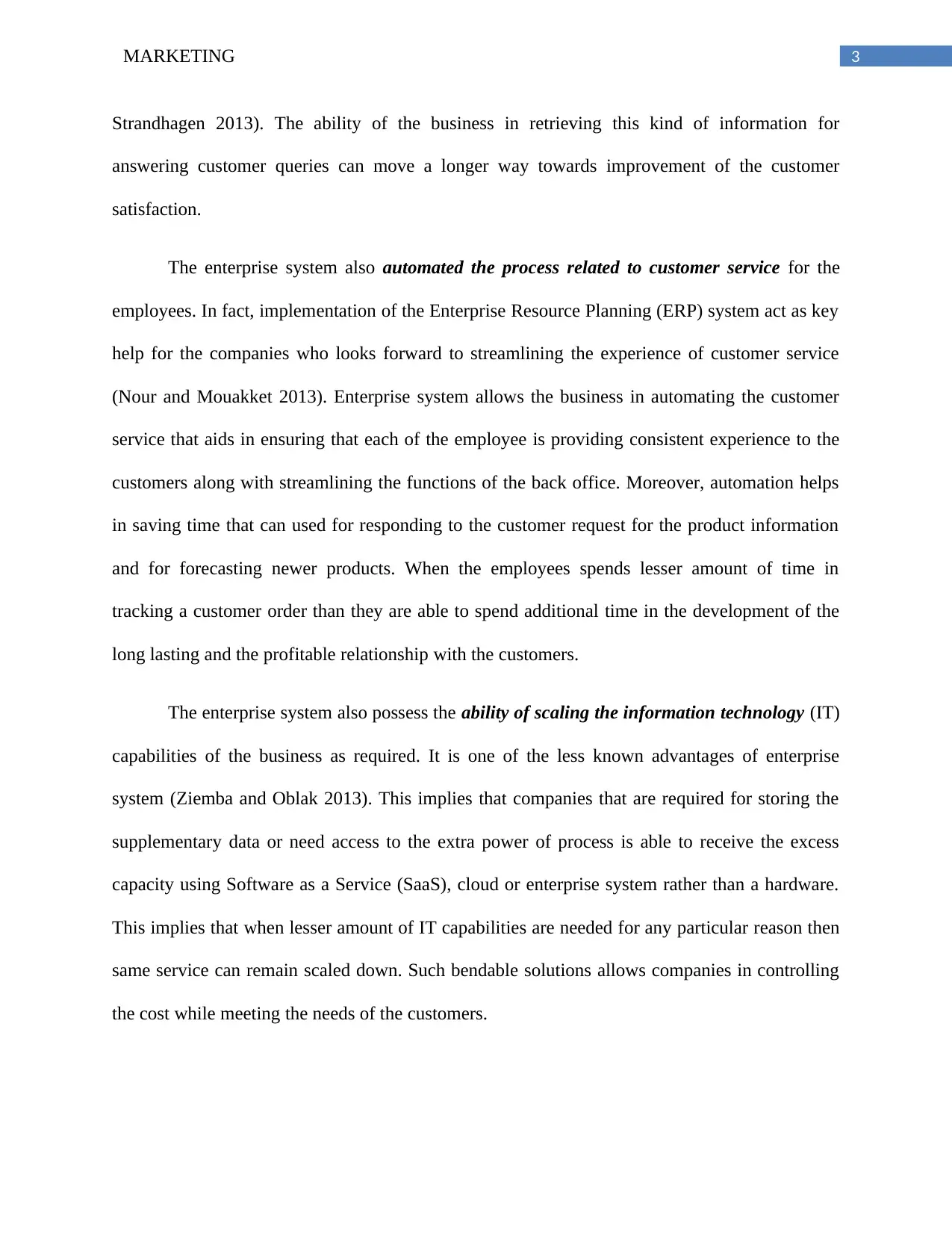
3MARKETING
Strandhagen 2013). The ability of the business in retrieving this kind of information for
answering customer queries can move a longer way towards improvement of the customer
satisfaction.
The enterprise system also automated the process related to customer service for the
employees. In fact, implementation of the Enterprise Resource Planning (ERP) system act as key
help for the companies who looks forward to streamlining the experience of customer service
(Nour and Mouakket 2013). Enterprise system allows the business in automating the customer
service that aids in ensuring that each of the employee is providing consistent experience to the
customers along with streamlining the functions of the back office. Moreover, automation helps
in saving time that can used for responding to the customer request for the product information
and for forecasting newer products. When the employees spends lesser amount of time in
tracking a customer order than they are able to spend additional time in the development of the
long lasting and the profitable relationship with the customers.
The enterprise system also possess the ability of scaling the information technology (IT)
capabilities of the business as required. It is one of the less known advantages of enterprise
system (Ziemba and Oblak 2013). This implies that companies that are required for storing the
supplementary data or need access to the extra power of process is able to receive the excess
capacity using Software as a Service (SaaS), cloud or enterprise system rather than a hardware.
This implies that when lesser amount of IT capabilities are needed for any particular reason then
same service can remain scaled down. Such bendable solutions allows companies in controlling
the cost while meeting the needs of the customers.
Strandhagen 2013). The ability of the business in retrieving this kind of information for
answering customer queries can move a longer way towards improvement of the customer
satisfaction.
The enterprise system also automated the process related to customer service for the
employees. In fact, implementation of the Enterprise Resource Planning (ERP) system act as key
help for the companies who looks forward to streamlining the experience of customer service
(Nour and Mouakket 2013). Enterprise system allows the business in automating the customer
service that aids in ensuring that each of the employee is providing consistent experience to the
customers along with streamlining the functions of the back office. Moreover, automation helps
in saving time that can used for responding to the customer request for the product information
and for forecasting newer products. When the employees spends lesser amount of time in
tracking a customer order than they are able to spend additional time in the development of the
long lasting and the profitable relationship with the customers.
The enterprise system also possess the ability of scaling the information technology (IT)
capabilities of the business as required. It is one of the less known advantages of enterprise
system (Ziemba and Oblak 2013). This implies that companies that are required for storing the
supplementary data or need access to the extra power of process is able to receive the excess
capacity using Software as a Service (SaaS), cloud or enterprise system rather than a hardware.
This implies that when lesser amount of IT capabilities are needed for any particular reason then
same service can remain scaled down. Such bendable solutions allows companies in controlling
the cost while meeting the needs of the customers.
Paraphrase This Document
Need a fresh take? Get an instant paraphrase of this document with our AI Paraphraser
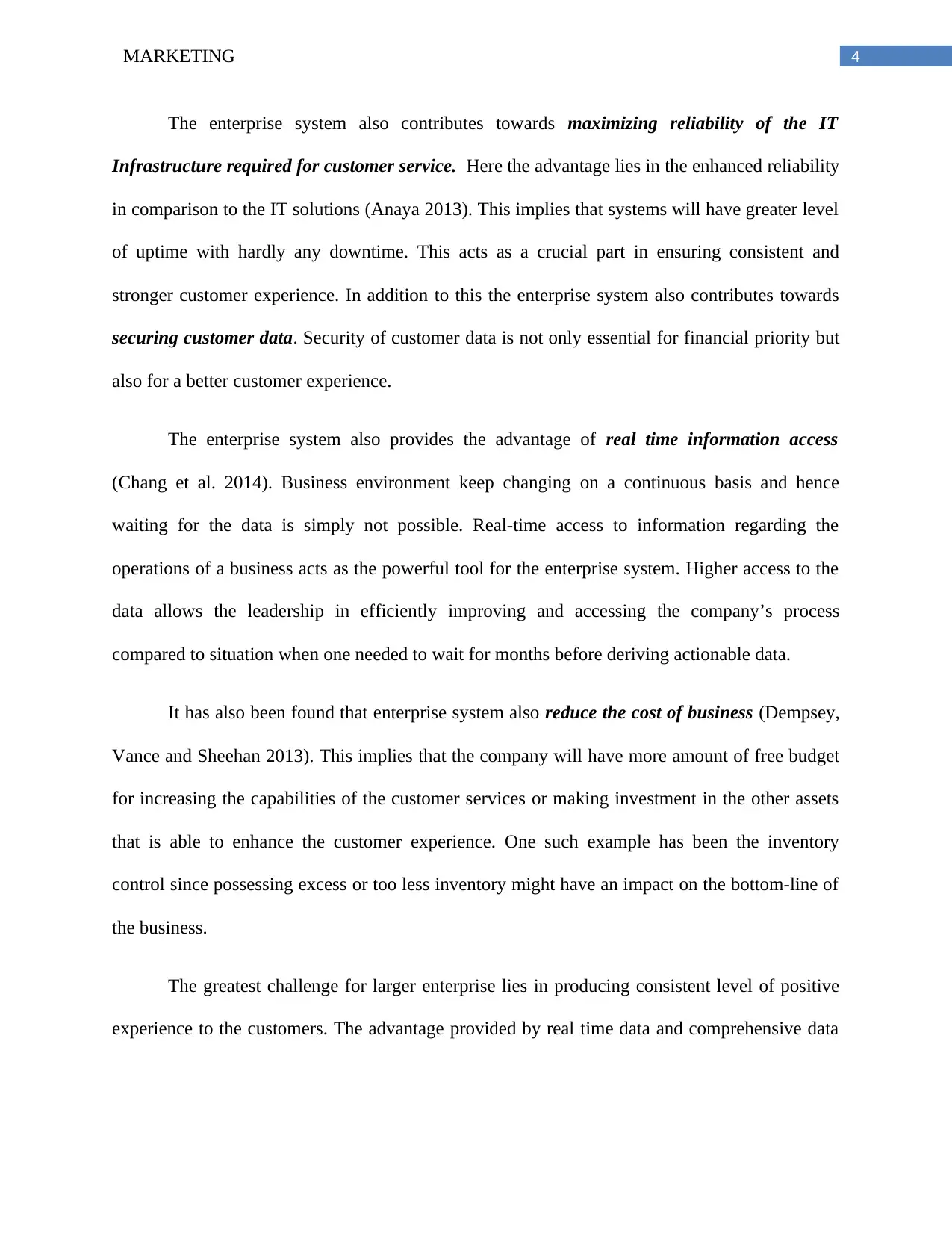
4MARKETING
The enterprise system also contributes towards maximizing reliability of the IT
Infrastructure required for customer service. Here the advantage lies in the enhanced reliability
in comparison to the IT solutions (Anaya 2013). This implies that systems will have greater level
of uptime with hardly any downtime. This acts as a crucial part in ensuring consistent and
stronger customer experience. In addition to this the enterprise system also contributes towards
securing customer data. Security of customer data is not only essential for financial priority but
also for a better customer experience.
The enterprise system also provides the advantage of real time information access
(Chang et al. 2014). Business environment keep changing on a continuous basis and hence
waiting for the data is simply not possible. Real-time access to information regarding the
operations of a business acts as the powerful tool for the enterprise system. Higher access to the
data allows the leadership in efficiently improving and accessing the company’s process
compared to situation when one needed to wait for months before deriving actionable data.
It has also been found that enterprise system also reduce the cost of business (Dempsey,
Vance and Sheehan 2013). This implies that the company will have more amount of free budget
for increasing the capabilities of the customer services or making investment in the other assets
that is able to enhance the customer experience. One such example has been the inventory
control since possessing excess or too less inventory might have an impact on the bottom-line of
the business.
The greatest challenge for larger enterprise lies in producing consistent level of positive
experience to the customers. The advantage provided by real time data and comprehensive data
The enterprise system also contributes towards maximizing reliability of the IT
Infrastructure required for customer service. Here the advantage lies in the enhanced reliability
in comparison to the IT solutions (Anaya 2013). This implies that systems will have greater level
of uptime with hardly any downtime. This acts as a crucial part in ensuring consistent and
stronger customer experience. In addition to this the enterprise system also contributes towards
securing customer data. Security of customer data is not only essential for financial priority but
also for a better customer experience.
The enterprise system also provides the advantage of real time information access
(Chang et al. 2014). Business environment keep changing on a continuous basis and hence
waiting for the data is simply not possible. Real-time access to information regarding the
operations of a business acts as the powerful tool for the enterprise system. Higher access to the
data allows the leadership in efficiently improving and accessing the company’s process
compared to situation when one needed to wait for months before deriving actionable data.
It has also been found that enterprise system also reduce the cost of business (Dempsey,
Vance and Sheehan 2013). This implies that the company will have more amount of free budget
for increasing the capabilities of the customer services or making investment in the other assets
that is able to enhance the customer experience. One such example has been the inventory
control since possessing excess or too less inventory might have an impact on the bottom-line of
the business.
The greatest challenge for larger enterprise lies in producing consistent level of positive
experience to the customers. The advantage provided by real time data and comprehensive data
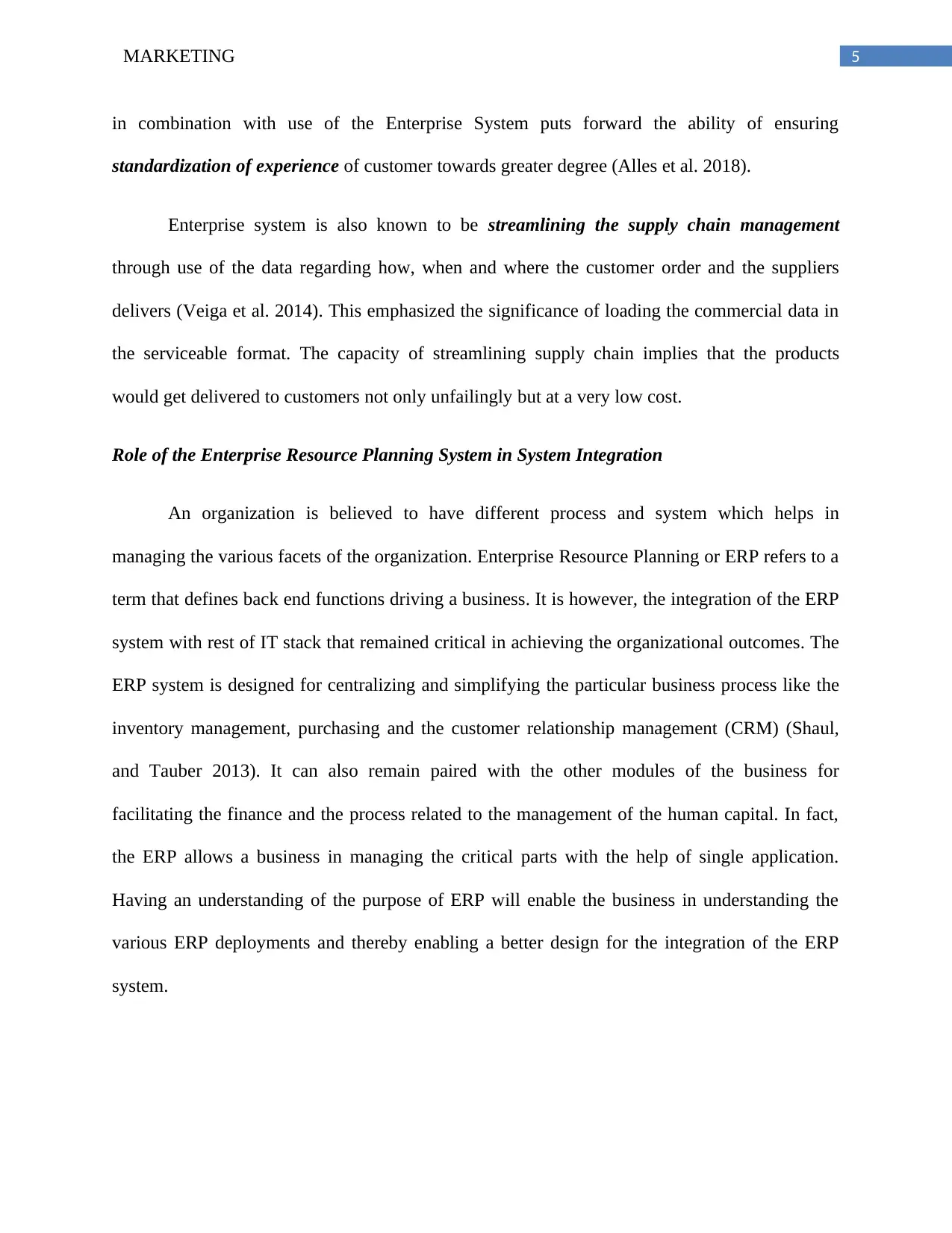
5MARKETING
in combination with use of the Enterprise System puts forward the ability of ensuring
standardization of experience of customer towards greater degree (Alles et al. 2018).
Enterprise system is also known to be streamlining the supply chain management
through use of the data regarding how, when and where the customer order and the suppliers
delivers (Veiga et al. 2014). This emphasized the significance of loading the commercial data in
the serviceable format. The capacity of streamlining supply chain implies that the products
would get delivered to customers not only unfailingly but at a very low cost.
Role of the Enterprise Resource Planning System in System Integration
An organization is believed to have different process and system which helps in
managing the various facets of the organization. Enterprise Resource Planning or ERP refers to a
term that defines back end functions driving a business. It is however, the integration of the ERP
system with rest of IT stack that remained critical in achieving the organizational outcomes. The
ERP system is designed for centralizing and simplifying the particular business process like the
inventory management, purchasing and the customer relationship management (CRM) (Shaul,
and Tauber 2013). It can also remain paired with the other modules of the business for
facilitating the finance and the process related to the management of the human capital. In fact,
the ERP allows a business in managing the critical parts with the help of single application.
Having an understanding of the purpose of ERP will enable the business in understanding the
various ERP deployments and thereby enabling a better design for the integration of the ERP
system.
in combination with use of the Enterprise System puts forward the ability of ensuring
standardization of experience of customer towards greater degree (Alles et al. 2018).
Enterprise system is also known to be streamlining the supply chain management
through use of the data regarding how, when and where the customer order and the suppliers
delivers (Veiga et al. 2014). This emphasized the significance of loading the commercial data in
the serviceable format. The capacity of streamlining supply chain implies that the products
would get delivered to customers not only unfailingly but at a very low cost.
Role of the Enterprise Resource Planning System in System Integration
An organization is believed to have different process and system which helps in
managing the various facets of the organization. Enterprise Resource Planning or ERP refers to a
term that defines back end functions driving a business. It is however, the integration of the ERP
system with rest of IT stack that remained critical in achieving the organizational outcomes. The
ERP system is designed for centralizing and simplifying the particular business process like the
inventory management, purchasing and the customer relationship management (CRM) (Shaul,
and Tauber 2013). It can also remain paired with the other modules of the business for
facilitating the finance and the process related to the management of the human capital. In fact,
the ERP allows a business in managing the critical parts with the help of single application.
Having an understanding of the purpose of ERP will enable the business in understanding the
various ERP deployments and thereby enabling a better design for the integration of the ERP
system.
⊘ This is a preview!⊘
Do you want full access?
Subscribe today to unlock all pages.

Trusted by 1+ million students worldwide
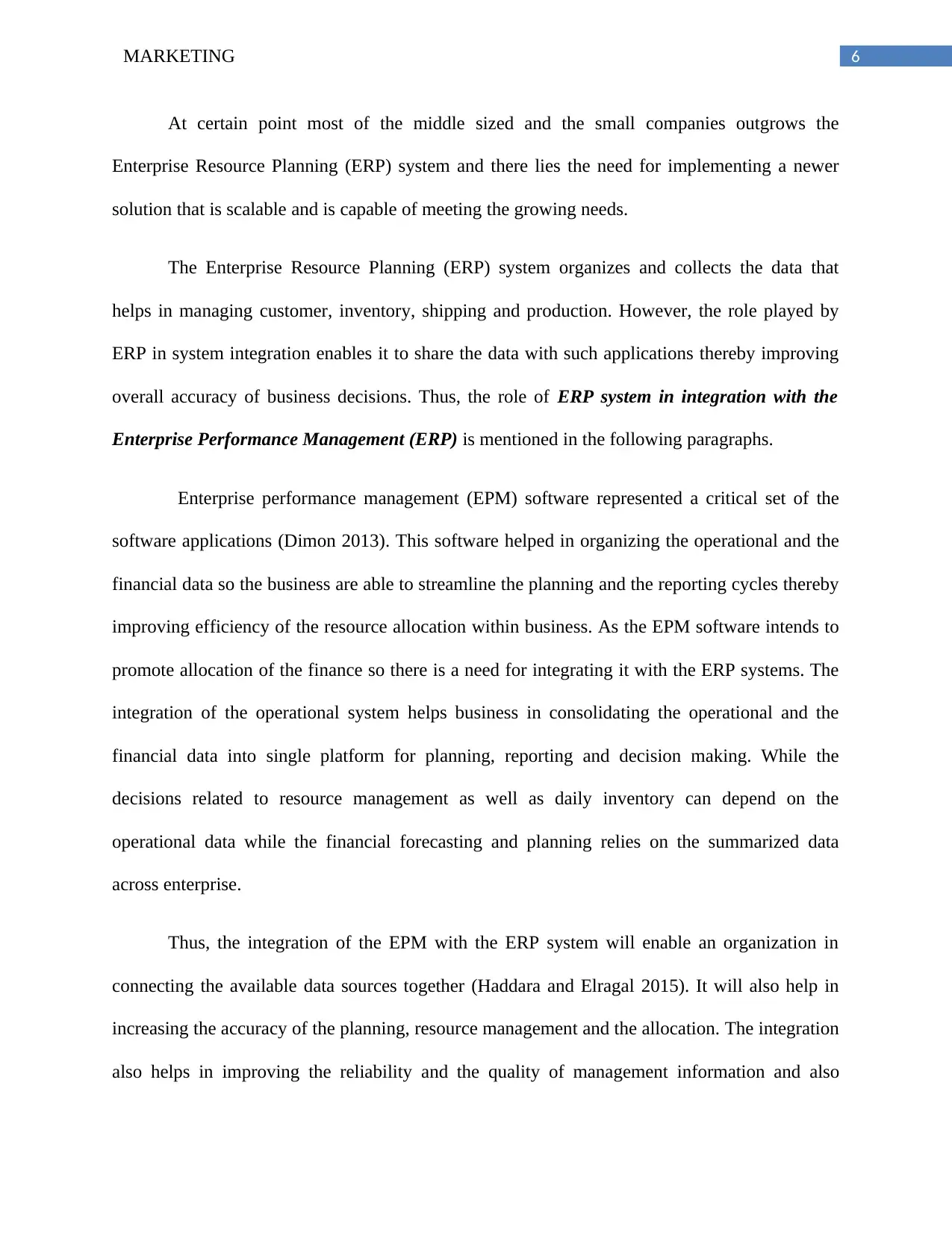
6MARKETING
At certain point most of the middle sized and the small companies outgrows the
Enterprise Resource Planning (ERP) system and there lies the need for implementing a newer
solution that is scalable and is capable of meeting the growing needs.
The Enterprise Resource Planning (ERP) system organizes and collects the data that
helps in managing customer, inventory, shipping and production. However, the role played by
ERP in system integration enables it to share the data with such applications thereby improving
overall accuracy of business decisions. Thus, the role of ERP system in integration with the
Enterprise Performance Management (ERP) is mentioned in the following paragraphs.
Enterprise performance management (EPM) software represented a critical set of the
software applications (Dimon 2013). This software helped in organizing the operational and the
financial data so the business are able to streamline the planning and the reporting cycles thereby
improving efficiency of the resource allocation within business. As the EPM software intends to
promote allocation of the finance so there is a need for integrating it with the ERP systems. The
integration of the operational system helps business in consolidating the operational and the
financial data into single platform for planning, reporting and decision making. While the
decisions related to resource management as well as daily inventory can depend on the
operational data while the financial forecasting and planning relies on the summarized data
across enterprise.
Thus, the integration of the EPM with the ERP system will enable an organization in
connecting the available data sources together (Haddara and Elragal 2015). It will also help in
increasing the accuracy of the planning, resource management and the allocation. The integration
also helps in improving the reliability and the quality of management information and also
At certain point most of the middle sized and the small companies outgrows the
Enterprise Resource Planning (ERP) system and there lies the need for implementing a newer
solution that is scalable and is capable of meeting the growing needs.
The Enterprise Resource Planning (ERP) system organizes and collects the data that
helps in managing customer, inventory, shipping and production. However, the role played by
ERP in system integration enables it to share the data with such applications thereby improving
overall accuracy of business decisions. Thus, the role of ERP system in integration with the
Enterprise Performance Management (ERP) is mentioned in the following paragraphs.
Enterprise performance management (EPM) software represented a critical set of the
software applications (Dimon 2013). This software helped in organizing the operational and the
financial data so the business are able to streamline the planning and the reporting cycles thereby
improving efficiency of the resource allocation within business. As the EPM software intends to
promote allocation of the finance so there is a need for integrating it with the ERP systems. The
integration of the operational system helps business in consolidating the operational and the
financial data into single platform for planning, reporting and decision making. While the
decisions related to resource management as well as daily inventory can depend on the
operational data while the financial forecasting and planning relies on the summarized data
across enterprise.
Thus, the integration of the EPM with the ERP system will enable an organization in
connecting the available data sources together (Haddara and Elragal 2015). It will also help in
increasing the accuracy of the planning, resource management and the allocation. The integration
also helps in improving the reliability and the quality of management information and also
Paraphrase This Document
Need a fresh take? Get an instant paraphrase of this document with our AI Paraphraser
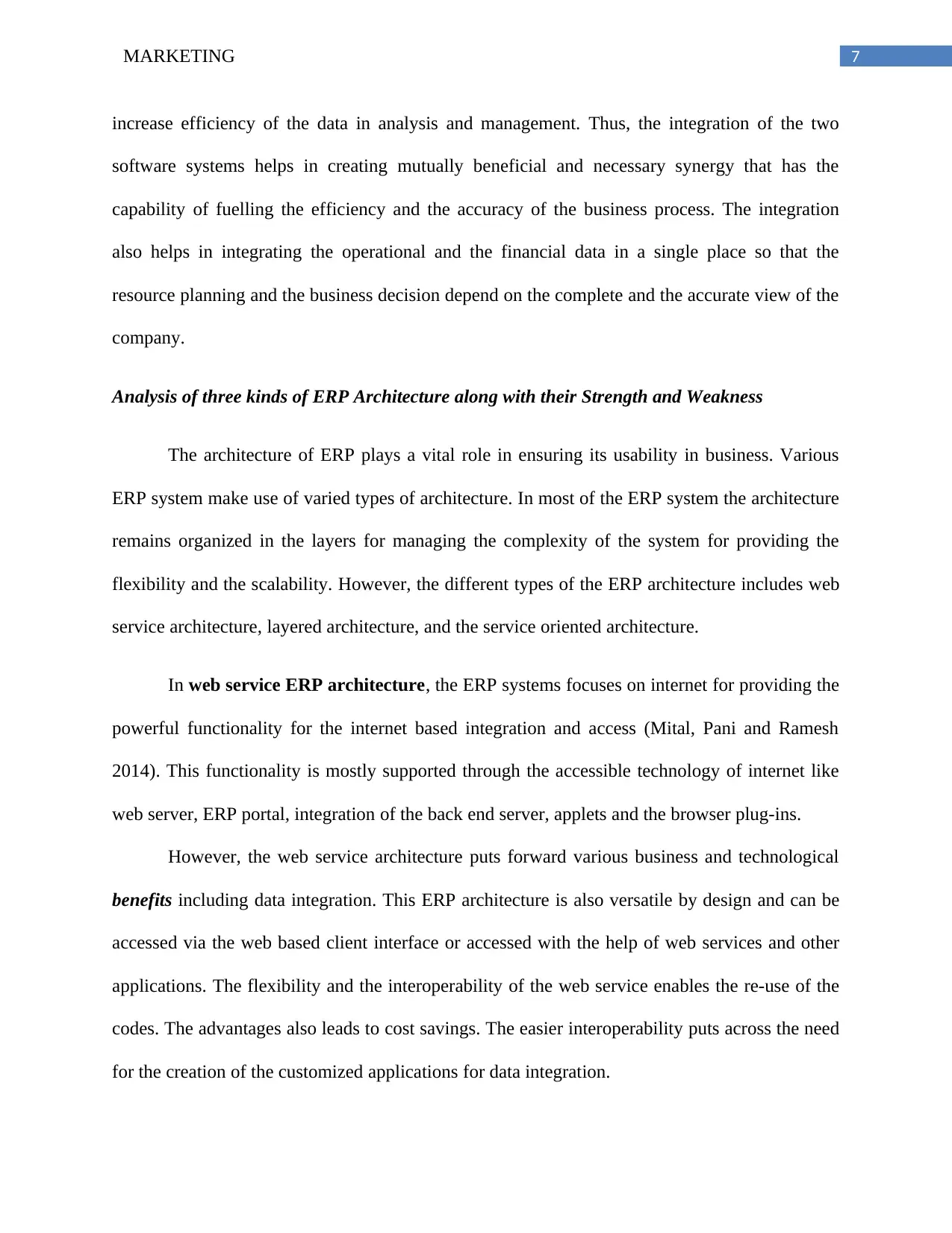
7MARKETING
increase efficiency of the data in analysis and management. Thus, the integration of the two
software systems helps in creating mutually beneficial and necessary synergy that has the
capability of fuelling the efficiency and the accuracy of the business process. The integration
also helps in integrating the operational and the financial data in a single place so that the
resource planning and the business decision depend on the complete and the accurate view of the
company.
Analysis of three kinds of ERP Architecture along with their Strength and Weakness
The architecture of ERP plays a vital role in ensuring its usability in business. Various
ERP system make use of varied types of architecture. In most of the ERP system the architecture
remains organized in the layers for managing the complexity of the system for providing the
flexibility and the scalability. However, the different types of the ERP architecture includes web
service architecture, layered architecture, and the service oriented architecture.
In web service ERP architecture, the ERP systems focuses on internet for providing the
powerful functionality for the internet based integration and access (Mital, Pani and Ramesh
2014). This functionality is mostly supported through the accessible technology of internet like
web server, ERP portal, integration of the back end server, applets and the browser plug-ins.
However, the web service architecture puts forward various business and technological
benefits including data integration. This ERP architecture is also versatile by design and can be
accessed via the web based client interface or accessed with the help of web services and other
applications. The flexibility and the interoperability of the web service enables the re-use of the
codes. The advantages also leads to cost savings. The easier interoperability puts across the need
for the creation of the customized applications for data integration.
increase efficiency of the data in analysis and management. Thus, the integration of the two
software systems helps in creating mutually beneficial and necessary synergy that has the
capability of fuelling the efficiency and the accuracy of the business process. The integration
also helps in integrating the operational and the financial data in a single place so that the
resource planning and the business decision depend on the complete and the accurate view of the
company.
Analysis of three kinds of ERP Architecture along with their Strength and Weakness
The architecture of ERP plays a vital role in ensuring its usability in business. Various
ERP system make use of varied types of architecture. In most of the ERP system the architecture
remains organized in the layers for managing the complexity of the system for providing the
flexibility and the scalability. However, the different types of the ERP architecture includes web
service architecture, layered architecture, and the service oriented architecture.
In web service ERP architecture, the ERP systems focuses on internet for providing the
powerful functionality for the internet based integration and access (Mital, Pani and Ramesh
2014). This functionality is mostly supported through the accessible technology of internet like
web server, ERP portal, integration of the back end server, applets and the browser plug-ins.
However, the web service architecture puts forward various business and technological
benefits including data integration. This ERP architecture is also versatile by design and can be
accessed via the web based client interface or accessed with the help of web services and other
applications. The flexibility and the interoperability of the web service enables the re-use of the
codes. The advantages also leads to cost savings. The easier interoperability puts across the need
for the creation of the customized applications for data integration.
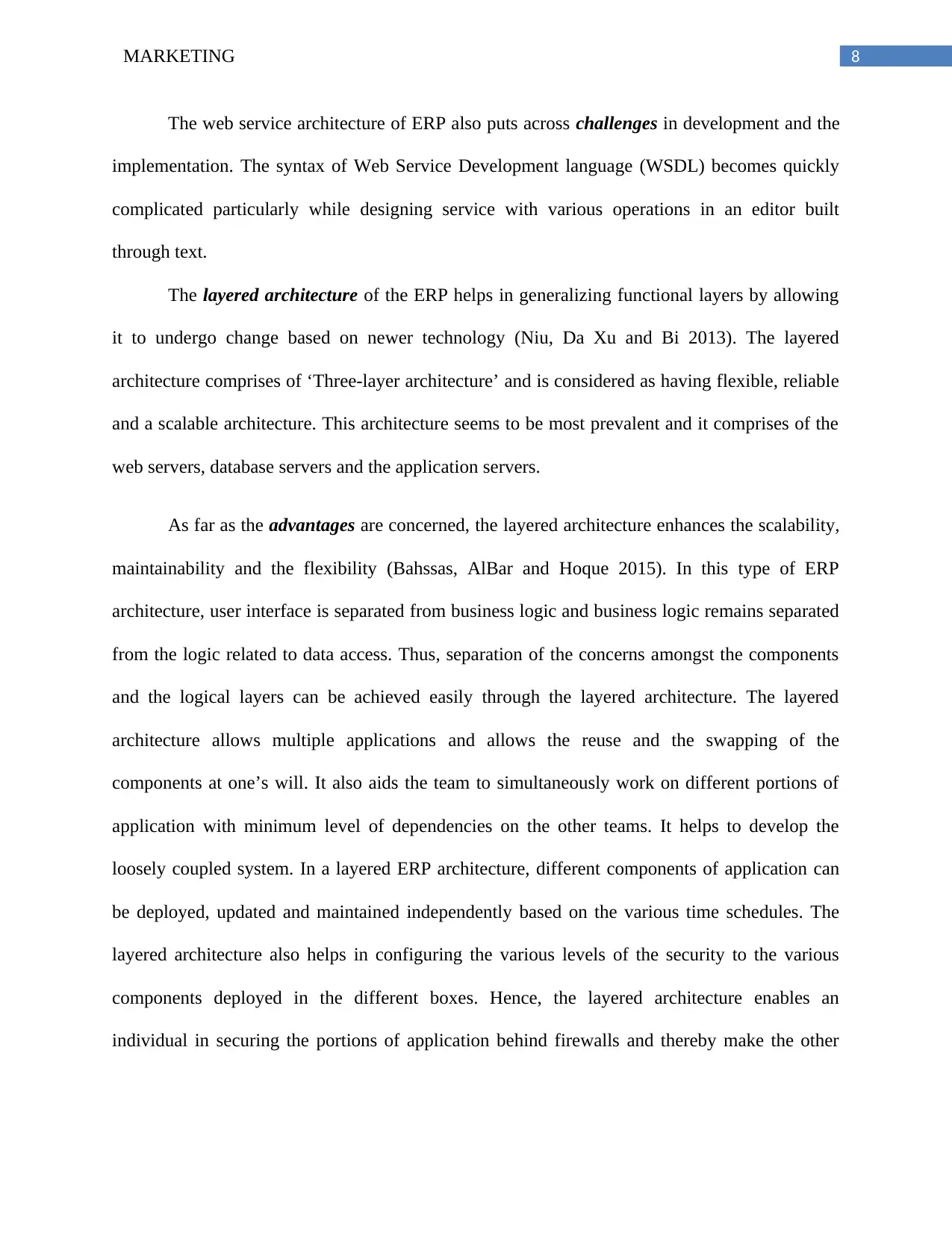
8MARKETING
The web service architecture of ERP also puts across challenges in development and the
implementation. The syntax of Web Service Development language (WSDL) becomes quickly
complicated particularly while designing service with various operations in an editor built
through text.
The layered architecture of the ERP helps in generalizing functional layers by allowing
it to undergo change based on newer technology (Niu, Da Xu and Bi 2013). The layered
architecture comprises of ‘Three-layer architecture’ and is considered as having flexible, reliable
and a scalable architecture. This architecture seems to be most prevalent and it comprises of the
web servers, database servers and the application servers.
As far as the advantages are concerned, the layered architecture enhances the scalability,
maintainability and the flexibility (Bahssas, AlBar and Hoque 2015). In this type of ERP
architecture, user interface is separated from business logic and business logic remains separated
from the logic related to data access. Thus, separation of the concerns amongst the components
and the logical layers can be achieved easily through the layered architecture. The layered
architecture allows multiple applications and allows the reuse and the swapping of the
components at one’s will. It also aids the team to simultaneously work on different portions of
application with minimum level of dependencies on the other teams. It helps to develop the
loosely coupled system. In a layered ERP architecture, different components of application can
be deployed, updated and maintained independently based on the various time schedules. The
layered architecture also helps in configuring the various levels of the security to the various
components deployed in the different boxes. Hence, the layered architecture enables an
individual in securing the portions of application behind firewalls and thereby make the other
The web service architecture of ERP also puts across challenges in development and the
implementation. The syntax of Web Service Development language (WSDL) becomes quickly
complicated particularly while designing service with various operations in an editor built
through text.
The layered architecture of the ERP helps in generalizing functional layers by allowing
it to undergo change based on newer technology (Niu, Da Xu and Bi 2013). The layered
architecture comprises of ‘Three-layer architecture’ and is considered as having flexible, reliable
and a scalable architecture. This architecture seems to be most prevalent and it comprises of the
web servers, database servers and the application servers.
As far as the advantages are concerned, the layered architecture enhances the scalability,
maintainability and the flexibility (Bahssas, AlBar and Hoque 2015). In this type of ERP
architecture, user interface is separated from business logic and business logic remains separated
from the logic related to data access. Thus, separation of the concerns amongst the components
and the logical layers can be achieved easily through the layered architecture. The layered
architecture allows multiple applications and allows the reuse and the swapping of the
components at one’s will. It also aids the team to simultaneously work on different portions of
application with minimum level of dependencies on the other teams. It helps to develop the
loosely coupled system. In a layered ERP architecture, different components of application can
be deployed, updated and maintained independently based on the various time schedules. The
layered architecture also helps in configuring the various levels of the security to the various
components deployed in the different boxes. Hence, the layered architecture enables an
individual in securing the portions of application behind firewalls and thereby make the other
⊘ This is a preview!⊘
Do you want full access?
Subscribe today to unlock all pages.

Trusted by 1+ million students worldwide
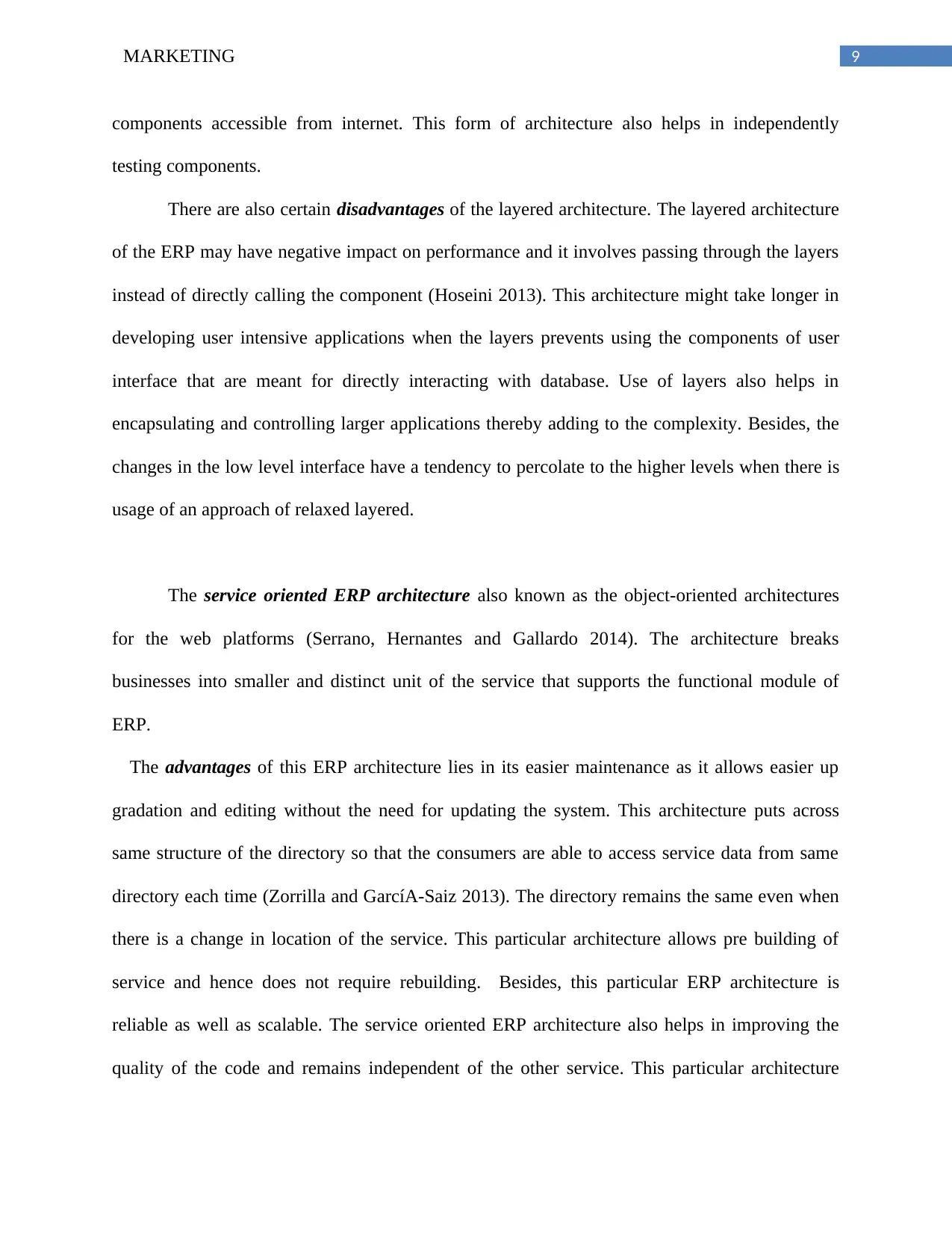
9MARKETING
components accessible from internet. This form of architecture also helps in independently
testing components.
There are also certain disadvantages of the layered architecture. The layered architecture
of the ERP may have negative impact on performance and it involves passing through the layers
instead of directly calling the component (Hoseini 2013). This architecture might take longer in
developing user intensive applications when the layers prevents using the components of user
interface that are meant for directly interacting with database. Use of layers also helps in
encapsulating and controlling larger applications thereby adding to the complexity. Besides, the
changes in the low level interface have a tendency to percolate to the higher levels when there is
usage of an approach of relaxed layered.
The service oriented ERP architecture also known as the object-oriented architectures
for the web platforms (Serrano, Hernantes and Gallardo 2014). The architecture breaks
businesses into smaller and distinct unit of the service that supports the functional module of
ERP.
The advantages of this ERP architecture lies in its easier maintenance as it allows easier up
gradation and editing without the need for updating the system. This architecture puts across
same structure of the directory so that the consumers are able to access service data from same
directory each time (Zorrilla and GarcíA-Saiz 2013). The directory remains the same even when
there is a change in location of the service. This particular architecture allows pre building of
service and hence does not require rebuilding. Besides, this particular ERP architecture is
reliable as well as scalable. The service oriented ERP architecture also helps in improving the
quality of the code and remains independent of the other service. This particular architecture
components accessible from internet. This form of architecture also helps in independently
testing components.
There are also certain disadvantages of the layered architecture. The layered architecture
of the ERP may have negative impact on performance and it involves passing through the layers
instead of directly calling the component (Hoseini 2013). This architecture might take longer in
developing user intensive applications when the layers prevents using the components of user
interface that are meant for directly interacting with database. Use of layers also helps in
encapsulating and controlling larger applications thereby adding to the complexity. Besides, the
changes in the low level interface have a tendency to percolate to the higher levels when there is
usage of an approach of relaxed layered.
The service oriented ERP architecture also known as the object-oriented architectures
for the web platforms (Serrano, Hernantes and Gallardo 2014). The architecture breaks
businesses into smaller and distinct unit of the service that supports the functional module of
ERP.
The advantages of this ERP architecture lies in its easier maintenance as it allows easier up
gradation and editing without the need for updating the system. This architecture puts across
same structure of the directory so that the consumers are able to access service data from same
directory each time (Zorrilla and GarcíA-Saiz 2013). The directory remains the same even when
there is a change in location of the service. This particular architecture allows pre building of
service and hence does not require rebuilding. Besides, this particular ERP architecture is
reliable as well as scalable. The service oriented ERP architecture also helps in improving the
quality of the code and remains independent of the other service. This particular architecture
Paraphrase This Document
Need a fresh take? Get an instant paraphrase of this document with our AI Paraphraser
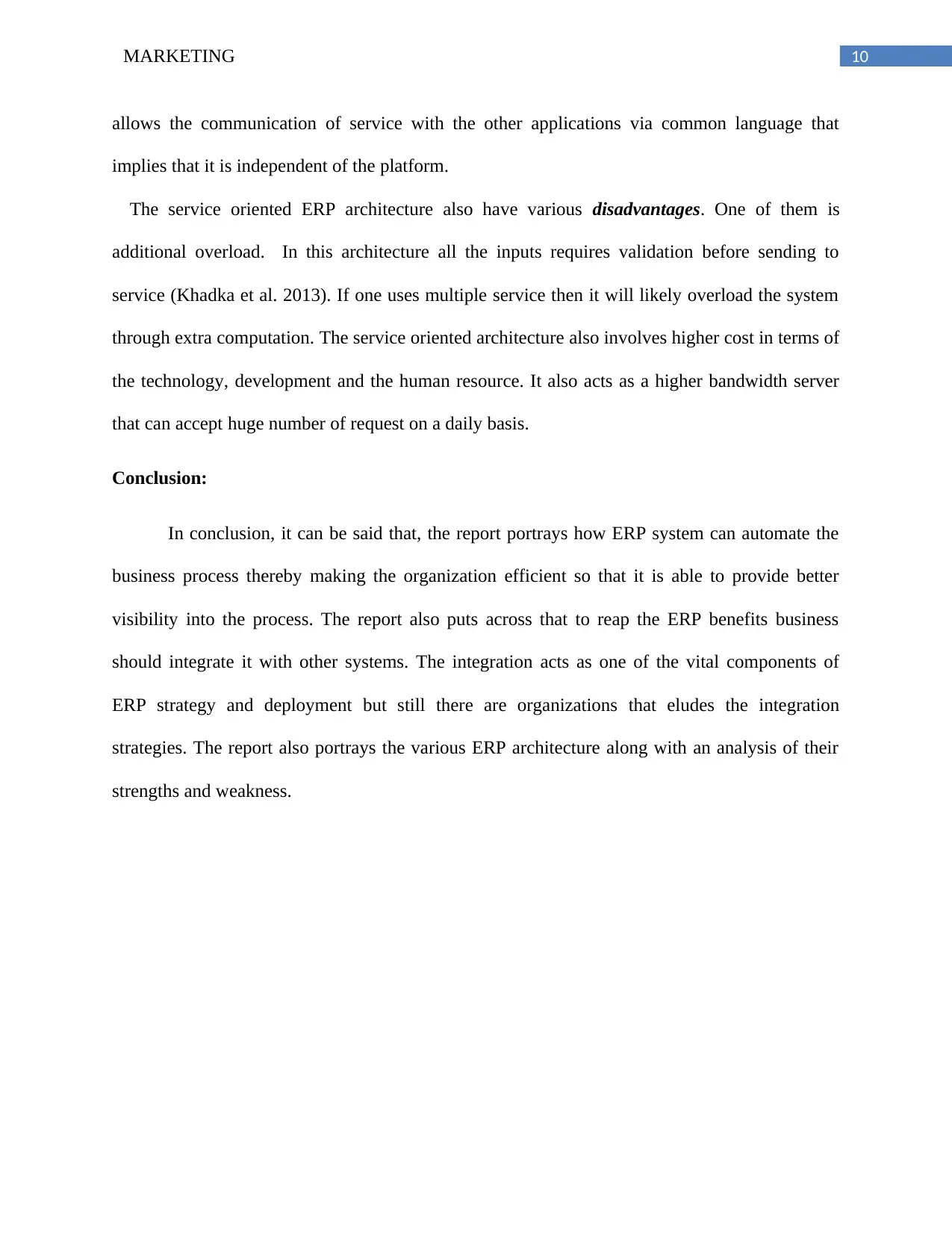
10MARKETING
allows the communication of service with the other applications via common language that
implies that it is independent of the platform.
The service oriented ERP architecture also have various disadvantages. One of them is
additional overload. In this architecture all the inputs requires validation before sending to
service (Khadka et al. 2013). If one uses multiple service then it will likely overload the system
through extra computation. The service oriented architecture also involves higher cost in terms of
the technology, development and the human resource. It also acts as a higher bandwidth server
that can accept huge number of request on a daily basis.
Conclusion:
In conclusion, it can be said that, the report portrays how ERP system can automate the
business process thereby making the organization efficient so that it is able to provide better
visibility into the process. The report also puts across that to reap the ERP benefits business
should integrate it with other systems. The integration acts as one of the vital components of
ERP strategy and deployment but still there are organizations that eludes the integration
strategies. The report also portrays the various ERP architecture along with an analysis of their
strengths and weakness.
allows the communication of service with the other applications via common language that
implies that it is independent of the platform.
The service oriented ERP architecture also have various disadvantages. One of them is
additional overload. In this architecture all the inputs requires validation before sending to
service (Khadka et al. 2013). If one uses multiple service then it will likely overload the system
through extra computation. The service oriented architecture also involves higher cost in terms of
the technology, development and the human resource. It also acts as a higher bandwidth server
that can accept huge number of request on a daily basis.
Conclusion:
In conclusion, it can be said that, the report portrays how ERP system can automate the
business process thereby making the organization efficient so that it is able to provide better
visibility into the process. The report also puts across that to reap the ERP benefits business
should integrate it with other systems. The integration acts as one of the vital components of
ERP strategy and deployment but still there are organizations that eludes the integration
strategies. The report also portrays the various ERP architecture along with an analysis of their
strengths and weakness.
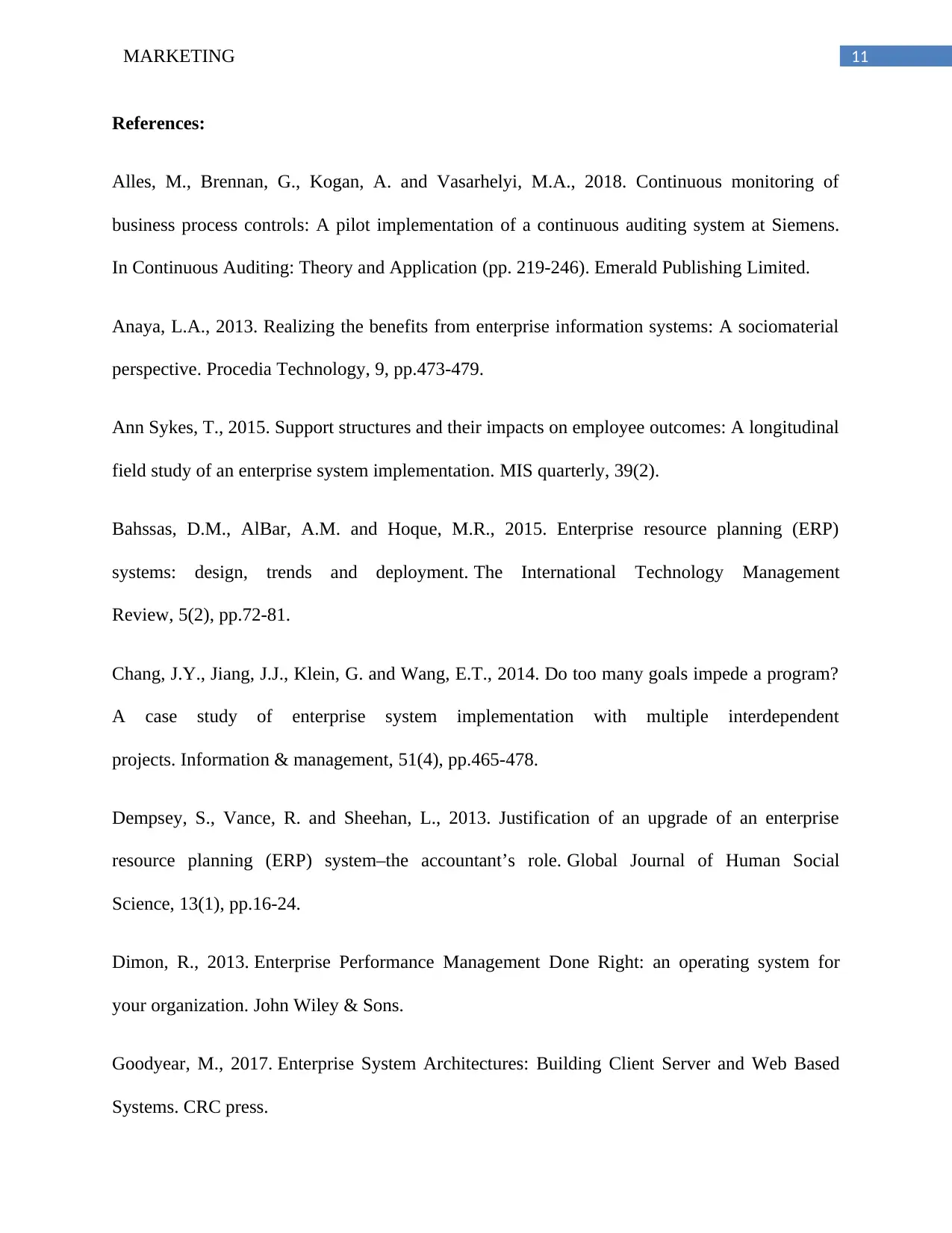
11MARKETING
References:
Alles, M., Brennan, G., Kogan, A. and Vasarhelyi, M.A., 2018. Continuous monitoring of
business process controls: A pilot implementation of a continuous auditing system at Siemens.
In Continuous Auditing: Theory and Application (pp. 219-246). Emerald Publishing Limited.
Anaya, L.A., 2013. Realizing the benefits from enterprise information systems: A sociomaterial
perspective. Procedia Technology, 9, pp.473-479.
Ann Sykes, T., 2015. Support structures and their impacts on employee outcomes: A longitudinal
field study of an enterprise system implementation. MIS quarterly, 39(2).
Bahssas, D.M., AlBar, A.M. and Hoque, M.R., 2015. Enterprise resource planning (ERP)
systems: design, trends and deployment. The International Technology Management
Review, 5(2), pp.72-81.
Chang, J.Y., Jiang, J.J., Klein, G. and Wang, E.T., 2014. Do too many goals impede a program?
A case study of enterprise system implementation with multiple interdependent
projects. Information & management, 51(4), pp.465-478.
Dempsey, S., Vance, R. and Sheehan, L., 2013. Justification of an upgrade of an enterprise
resource planning (ERP) system–the accountant’s role. Global Journal of Human Social
Science, 13(1), pp.16-24.
Dimon, R., 2013. Enterprise Performance Management Done Right: an operating system for
your organization. John Wiley & Sons.
Goodyear, M., 2017. Enterprise System Architectures: Building Client Server and Web Based
Systems. CRC press.
References:
Alles, M., Brennan, G., Kogan, A. and Vasarhelyi, M.A., 2018. Continuous monitoring of
business process controls: A pilot implementation of a continuous auditing system at Siemens.
In Continuous Auditing: Theory and Application (pp. 219-246). Emerald Publishing Limited.
Anaya, L.A., 2013. Realizing the benefits from enterprise information systems: A sociomaterial
perspective. Procedia Technology, 9, pp.473-479.
Ann Sykes, T., 2015. Support structures and their impacts on employee outcomes: A longitudinal
field study of an enterprise system implementation. MIS quarterly, 39(2).
Bahssas, D.M., AlBar, A.M. and Hoque, M.R., 2015. Enterprise resource planning (ERP)
systems: design, trends and deployment. The International Technology Management
Review, 5(2), pp.72-81.
Chang, J.Y., Jiang, J.J., Klein, G. and Wang, E.T., 2014. Do too many goals impede a program?
A case study of enterprise system implementation with multiple interdependent
projects. Information & management, 51(4), pp.465-478.
Dempsey, S., Vance, R. and Sheehan, L., 2013. Justification of an upgrade of an enterprise
resource planning (ERP) system–the accountant’s role. Global Journal of Human Social
Science, 13(1), pp.16-24.
Dimon, R., 2013. Enterprise Performance Management Done Right: an operating system for
your organization. John Wiley & Sons.
Goodyear, M., 2017. Enterprise System Architectures: Building Client Server and Web Based
Systems. CRC press.
⊘ This is a preview!⊘
Do you want full access?
Subscribe today to unlock all pages.

Trusted by 1+ million students worldwide
1 out of 14
Related Documents
Your All-in-One AI-Powered Toolkit for Academic Success.
+13062052269
info@desklib.com
Available 24*7 on WhatsApp / Email
![[object Object]](/_next/static/media/star-bottom.7253800d.svg)
Unlock your academic potential
Copyright © 2020–2025 A2Z Services. All Rights Reserved. Developed and managed by ZUCOL.





